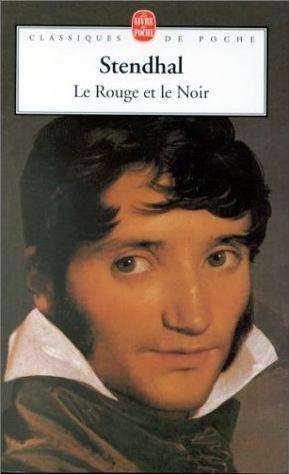The Red and The Black

The Red and The Black is a famous novel of the French author Stendhal, dealing with the society of France in the 19th century.
Julien Sorel is a young dreamer, preferring to read his books and daydream about Napoleon than to do something useful for his family. He becomes an acolyte and then obtains a job as a tutor in the prestigious house of Monsieur de Rênal, mayor of Verrières. However, he pays less attention to The Bible than to the mayor’s wife.
Soon he finds involved in the political turmoil of the age and starts being manipulated by all kinds of factions, just as he’s trying to forget Madame de Rênal and starts trying to court the daughter of his new boss, Mathilde de la Mole.
Of course, things go downhill from there.
- Altum Videtur: Julien can impress people citing memorized passages of the Bible in Latin. He pays little attention to the holy book beyond that.
- Anti-Hero/Villain Protagonist: Julien.
- Betty and Veronica: Madame de Rênal and Mathilde de la Mole, respectively.
- The Casanova: Julien.
- Coming of Age Story: Julien leaves the nest, climbs his way to the top using talent, hard work and hypocrisy and learns that nothing is as nice as it seems.
- Corrupt Church: The church, with some individual exceptions, is generically composed of hypocrites pulling political threads in the shadows.
- Distracted by the Sexy: Julien gets distracted by an unsuccessful love affair of the letter he has to memorize to deliver it (he can’t get caught with it, so he can’t have it written). He manages to memorize it, but as a result of his distraction doesn’t get the subtext of the legitimist plot in it, the very faction he opposes.
- Doomed Moral Victor: Played with, as the reader is meant to see Julien as this when he is able to happily go to the guillotine after finally renouncing his Holier Than Thou persona and religion in general, and being authentic for the first time, despite the fact that society as a whole likely views him as scum.
- Duel to the Death: Monsieur de Croisenois fights on a duel for Mathilde's honour. He loses.
- Epigraph: All the chapters have epigraphs of well-known writers or others that sound like smart guys. Many of them were invented by Stendhal (like the one at the top).
- Evil Jesuit: Averted with the abbé Pirard. Played straight with the rest.
- Gratuitous English: Some of the epigraphs are in untranslated English. In a straighter (albeit meta) example, it seems that Stendhal occasionally liked to insert English words into French sentences for no apparent reason. The notes he wrote on the blank pages following the end of Book I in his copy of the work illustrate this.
Excerpt: "20 mai 1830. Je consign le 7e sheet of Le Rouge."[3]
- It's Pronounced Tro PAY: The Comte de Thaler. His name is German and should be pronounced “Thalay” in France.
- May-December Romance: Julien starts an affair with Madame de Rênal.
- No Title: The last four chapters don’t have titles at all.
- The Noun and the Noun
- Rags to Riches
- Sexy Priest: Julien, though technically he only gets to be an acolyte.
- Spell My Name with a Blank
- Traumatic Haircut: Self-inflicted by Mathilda.
- Tsundere: Mathilde, especially toward Julien. She also displays some Yandere qualities.
- Unwitting Instigator of Doom: Julien Sorel.
- Unwitting Pawn: Julien is used in a legitimist plot against his better judgment.